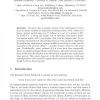Free Online Productivity Tools
i2Speak
i2Symbol
i2OCR
iTex2Img
iWeb2Print
iWeb2Shot
i2Type
iPdf2Split
iPdf2Merge
i2Bopomofo
i2Arabic
i2Style
i2Image
i2PDF
iLatex2Rtf
Sci2ools
ESA
2000
Springer
2000
Springer
K-D Trees Are Better when Cut on the Longest Side
We show that a popular variant of the well known k-d tree data structure satisfies an important packing lemma. This variant is a binary spatial partitioning tree T defined on a set of n points in IRd , for fixed d 1, using the simple rule of splitting each node's hyperrectangular region with a hyperplane that cuts the longest side. An interesting consequence of the packing lemma is that standard algorithms for performing approximate nearest-neighbor searching or range searching queries visit at most O(logd-1 n) nodes of such a tree T in the worst case. Traditionally, many variants of k-d trees have been empirically shown to exhibit polylogarithmic performance, and under certain restrictions in the data distribution some theoretical expected case results have been proven. This result, however, is the first one proving a worst-case polylogarithmic time bound for approximate geometric queries using the simple k-d tree data structure.
| Added | 24 Aug 2010 |
| Updated | 24 Aug 2010 |
| Type | Conference |
| Year | 2000 |
| Where | ESA |
| Authors | Matthew Dickerson, Christian A. Duncan, Michael T. Goodrich |
Comments (0)

